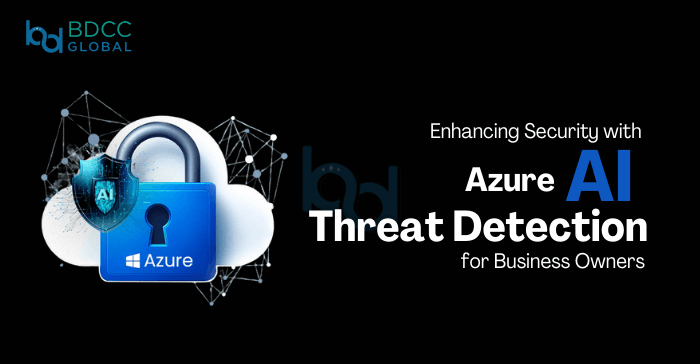
Cybersecurity is no longer a “tech-only” concern. It’s a business-critical priority. With ransomware, phishing, and insider threats growing smarter and faster, executives must think beyond traditional tools. That’s where Azure AI threat detection and Microsoft’s intelligent ecosystem step in—turning reactive security into a proactive, AI-driven defense.
Let’s explore how Azure’s intelligent threat detection can help your business stay secure, resilient, and audit-ready.
Why Your Business Needs AI-Driven Cybersecurity
You’ve probably invested in firewalls, antivirus, maybe even a basic SIEM. But here’s the hard truth: those tools weren’t designed for today’s threat landscape. Attackers are using automation, social engineering, and cloud vulnerabilities to get ahead.
That’s why AI-driven cybersecurity in Azure isn’t just a luxury—it’s essential. Azure harnesses machine learning and vast datasets to detect threats faster than any human could.
It’s not about replacing your security team—it’s about supercharging them. For all that you need some essential Azure finance tools for strengthening your cost management strategy.
What Makes Azure’s Security Ecosystem Unique?
Let’s talk about what sets Azure apart:
- Global reach, local impact: Microsoft processes 65 trillion+ signals daily from its global user base, feeding into Microsoft Azure threat intelligence.
- Built-in AI capabilities: Azure’s threat detection uses behavioral analytics and anomaly detection—not just signatures.
- Integrated tools: Azure combines SIEM (Microsoft Sentinel), extended detection and response (XDR), and Azure security posture management into one connected ecosystem.
The result? You get visibility, automation, and AI-powered protection across your entire environment.
Microsoft Azure Threat Intelligence: Your Global Security Feed
At the heart of Azure’s security capabilities is Microsoft Azure threat intelligence. This isn’t a database—it’s a living, breathing, global detection system.
It draws from:
- Microsoft 365 activity logs
- Azure network and identity telemetry
- Billions of threat signals across endpoints, cloud apps, and infrastructure
- Human security experts and Microsoft’s internal Red Team
This massive dataset trains Azure’s AI to recognize patterns—detecting threats that might otherwise slip past your internal systems. And you benefit from these insights in real time, with zero setup needed.
Azure Security Posture Management: Always-On Risk Reduction
Security posture isn’t just about reacting to threats—it’s about being prepared for them.
Azure security posture management (ASPM) is Microsoft’s continuous approach to strengthening your environment. It’s like a fitness tracker, but for your infrastructure. It constantly monitors, scores, and guides improvements.
With Microsoft Defender for Cloud, you get:
- A secure score that reflects your environment’s current risk level
- Automated recommendations (e.g., enable MFA, encrypt storage accounts)
- Regulatory compliance dashboards (GDPR, ISO 27001, NIST, etc.)
- Asset visibility across Azure, on-prem, and multi-cloud via Azure Arc
This empowers your team to prioritize the highest-impact fixes—no guesswork needed.
Inside Azure AI Threat Detection: How the Magic Happens
So how does AI actually detect threats in Azure? Let’s break it down.
Behavioral Analytics
Instead of relying on known threats, Azure builds a baseline of “normal” behavior across your users, devices, and applications.
- A user always logs in from New York at 9am?
- Suddenly logging in from Russia at 2am? That’s flagged.
These subtle deviations are often early indicators of compromise.
Threat Signal Correlation (Fusion)
Azure’s Fusion engine automatically connects multiple low-level alerts into one high-fidelity incident. Instead of bombarding your team with 50 notifications, it delivers one consolidated insight.
For example:
- Alert 1: Suspicious login
- Alert 2: Mass file downloads
- Alert 3: Privilege escalation
Fusion sees this as a coordinated attack—not three unrelated events.
Built-in Threat Playbooks
With Microsoft Sentinel, you can automate responses to specific triggers:
- Disable a compromised user
- Isolate a virtual machine
- Notify your security operations team
- Launch investigation workflows
All without manual intervention.
Real-World Scenarios: From Threat to Response
Let’s walk through two more practical use cases that show Azure’s AI in action.
Scenario 1: Credential Stuffing Attempt
A botnet tries logging into your employee accounts using a database of leaked credentials.
- Azure detects high-volume failed login attempts.
- It flags abnormal IP behavior and matches it with known attack vectors via Microsoft threat intelligence.
- Sentinel triggers a playbook: accounts are locked, IPs blocked, admins notified.
All within minutes—without needing a human to watch the logs.
Scenario 2: Unusual Resource Behavior
An attacker exploits a misconfigured container to mine cryptocurrency.
- Azure monitors resource usage patterns (CPU, network, storage).
- Anomalies trigger alerts when consumption spikes beyond the norm.
- Defender for Cloud surfaces the vulnerability; Sentinel auto-tags the affected node.
In both cases, AI-driven cybersecurity in Azure reduces the time between detection and action to near-zero.
Why Business Owners Should Care
You might be thinking—this all sounds technical. But here’s why it matters to you as a decision-maker:
Reputation Protection
One breach can destroy years of brand equity. Azure’s proactive tools help prevent PR nightmares before they happen.
Reduced Risk = Lower Cost
Security incidents can cost millions in downtime, recovery, and legal exposure. Preventing one major attack easily pays for Azure’s security stack.
Audit-Ready Compliance
No more last-minute scrambles. Azure keeps your environments aligned with industry frameworks, and provides evidence for auditors out of the box.
Business Continuity at Scale
Whether you’re scaling to new regions or integrating new tools, Azure security adapts without disruption.
Getting Started: A Roadmap for Business Leaders
You don’t have to be a security expert to implement this. Start small:
- Enable Microsoft Defender for Cloud – It’s free to start and gives immediate insights.
- Onboard Microsoft Sentinel – Begin monitoring key workloads with built-in rules.
- Run a Secure Score Assessment – Use the recommendations to drive quarterly security objectives.
- Adopt Azure Arc – Extend detection to on-prem or multi-cloud systems for complete coverage.
- Use Automation Judiciously – Set up playbooks that handle low-risk incidents automatically.
Involve your security, compliance, and operations teams early—but lead the conversation as a business priority, not just an IT project.
Final Thoughts
The modern threat landscape is unpredictable—but your response to it doesn’t have to be.
With Azure AI threat detection, Azure security posture management, and Microsoft Azure threat intelligence, you’re not just defending against attacks. You’re building a smarter, more resilient business foundation—powered by real-time insights, automation, and global intelligence.
Security isn’t a product. It’s a mindset. And Azure helps you get there—faster, smarter, and without draining your resources.
BDCC
Latest posts by BDCC (see all)
- Enhancing Security Posture with Azure’s AI-Driven Threat Detection - April 15, 2025
- Why Golang is Becoming the Go-To Language for DevOps Engineers - April 11, 2025
- Azure Arc: Extending Azure Services to Hybrid and Multi-Cloud Environments - April 8, 2025

